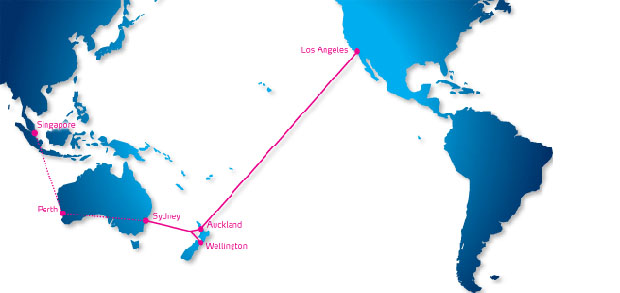Pacnet joins $447m US, NZ, Aus cable


Asian telco Pacnet has joined the Pacific Fibre consortium, which aims to build a 13,600km undersea fibre telecommunications cable between Australia, New Zealand and the United States.

The planned route (Credit: Pacnet)
When the project was first mooted in March this year, the Pacific Fibre group included a number of high-flying Kiwi businessmen such as the Warehouse founder Stephen Tindall, Trade Me founder Sam Morgan, Xero CEO Rod Drury, former Vodafone marketing chief Mark Rushworth (who is Pacific Fibre's CEO) and others.
Pacnet today revealed it would join with the consortium in an equal partnership to build the cable, with each partner to own and operate a new fibre pair in the cable. They will share responsibility for the cable supply contract as well as operations and maintenance costs.
Back in March, Rushworth estimated the cost of the cable at just under NZ$900 million (AU$736 million). But today the pair put the price of the cable at US$400 million (AU$447 million).
"It's great to have Pacnet join us as equal partners," said Rushworth in a statement today. "This even further validates the need for a new cable to Australia and New Zealand, and will ensure the success of the Pacific Fibre system. Pacnet has done this before as the largest investor within Unity cable group, and we are already benefiting from working with them.
"We are also very happy to announce a further reduction in our estimated system build costs to around US$400m."
Pacnet chief executive Bill Barney said the new cable would be essential to delivering international connectivity required by Australia and New Zealand as both countries build national broadband networks.
"This investment is also an integral part of our overall strategy to expand our subsea cable infrastructure into the Australasia region: to complement our pan-Asian and Trans-Pacific network coverage and boost broadband connectivity into Asia," he said.
Barney said the cable would be carrier neutral, with all Australian telcos able to apply for access. Barney said that at the moment, for every $100 a customer spends, $81 is going towards international capacity. He hoped that new cables could bring this closer to Korea and Japan's $16 to $20, although he said it would never get down quite that far.
Lower prices would not bring unmetered services, he believed. "You may still have metered services," Barney said, "but you won't be paying as much."
According to Barney, requests for proposal for vendors will go out in September or October this year, and said he expected players like Tyco, Alcatel-Lucent, NEC and Huawei would all express interest. Barney said the cable will be "in the water" by the end of 2011 and is expected to be ready for service by 2013.
Each fibre pair is expected to provide 64 wavelengths, which will facilitate a total capacity of 5.12 terabits per second, as each wavelength will support 40 gigabits per second (Gbps). Eventually, each wavelength may be able to support 100Gbps as technology evolves. As the cable is direct from Auckland to the US, it is expected to have a latency of 66 milliseconds, compared to its closest rival Telstra, which has a cable latency of 69 milliseconds.